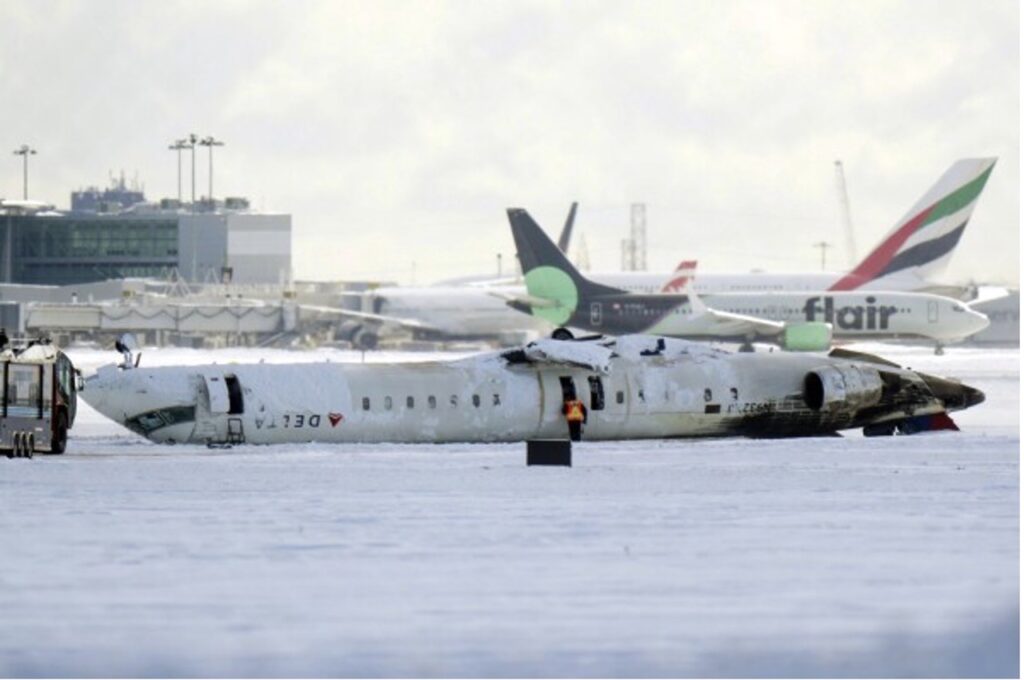News stories about recent plane crashes present a prime opportunity for CPSTs to promote safety when flying with children, including the importance of using a CR on aircraft.

(Photo Credit: Chris Young/The Canadian Press via AP)
In February, a Delta flight from Minneapolis crashed upon landing in Toronto. The highly publicized crash was touted as a miracle because, despite the aircraft losing its wings and flipping upside down, no one was killed. In the absence of deaths, news focused on those who were critically injured, including an 18-month-old baby seated on a parent’s lap.
Happily, that child’s condition has improved. But, several news outlets made the point that the child was among only a handful of injured passengers, and—even more helpful to the CPS cause—the Associated Press published an article titled “Plane that flipped over in Canada highlights some of the dangers of holding kids on your lap.” Having this title in the major news cycle was a boon to CPS education, even if caregivers didn’t read the full article. (Click here to read the article.)
Then, in April, a private plane carrying six family members crash-landed in Georgia. While the crash critically injured some of the adults, the two children aboard, ages 1 and 3, sustained no injuries. As Nuna shared on social media, their parents had buckled them up in a Nuna Rava and WAYB Pico, respectively, for the flight.
These stories help debunk the myth that a CR could not possibly be protective in a plane crash. That narrative, which focuses only on the worst-case crash and ignores several risks that are far more common, is used to help justify a choice not to use a CR on aircraft. Of course, that parents would lean toward not using a CR during flight is understandable; caregivers know that CRs are heavy to haul and tricky to install on aircraft. Also, the FAA allows children under age 2 to sit on an adult’s lap, a major cost savings to families. Caregivers often don’t realize that the FAA nonetheless recommends that young children ride in a CR during flight.
CPSTs, therefore, must make a very compelling case for best practice. That message can be bolstered by major news events, like those that have occurred this year, which highlight the value of using a CR on a plane—and the risks of not using one.
Anecdotally, I’ve detected an uptick in the usage of CRs on airplanes since February. I fly frequently, and while I typically don’t see CRs used on planes, I’ve noted several infants and toddlers using CRs in the last few months. So I’ve wondered: Has recent news influenced caregiver behavior? And, is this a moment we can seize upon to build more awareness?
This seems plausible, so let’s not squander the opportunity to use this momentum. Be sure that caregivers, especially those who say they have travel plans, are aware that:
- Plane crashes often occur during takeoff, landing, or while taxiing. These are crash types where a CR could provide important protection for children.
- CRs are key to protecting children during turbulence, a danger that’s much more common than crashes. And, since pilots cannot anticipate all turbulence—including severe clear-air turbulence—it’s best to keep children buckled up properly in a CR for as much of a flight as possible.
- Children on airplanes are sometimes injured by falling objects, like stowed luggage or hot beverages, or by items being rolled through the aisle. A CR can help protect a child from these injuries, especially when installed appropriately where it does not block egress for other passengers (i.e., by the window or in the center of a center row of seats).
Another important development is that the FAA recently modernized guidance for CR use and updated its webpage that supports families flying with children.
Learn more about the FAA’s updated guidance and website, as well as other resources that are available to educate CPSTs and caregivers about CPS on airplanes—including a free handout from Safe Ride News Publications—here.
